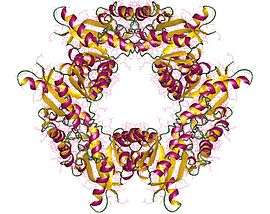Nicotinamide-nucleotide adenylyltransferase
In enzymology, nicotinamide-nucleotide adenylyltransferase (NMNAT) (EC 2.7.7.1) are enzymes that catalyzes the chemical reaction
- ATP + nicotinamide ribonucleotide diphosphate + NAD+
| nicotinamide-nucleotide adenylyltransferase | |||||||||
|---|---|---|---|---|---|---|---|---|---|
 Nicotinamide-nucleotide adenylyltransferase (nuclear) hexamer, Human | |||||||||
| Identifiers | |||||||||
| EC number | 2.7.7.1 | ||||||||
| CAS number | 9032-70-6 | ||||||||
| Databases | |||||||||
| IntEnz | IntEnz view | ||||||||
| BRENDA | BRENDA entry | ||||||||
| ExPASy | NiceZyme view | ||||||||
| KEGG | KEGG entry | ||||||||
| MetaCyc | metabolic pathway | ||||||||
| PRIAM | profile | ||||||||
| PDB structures | RCSB PDB PDBe PDBsum | ||||||||
| Gene Ontology | AmiGO / QuickGO | ||||||||
| |||||||||
Thus, the two substrates of this enzyme are ATP and nicotinamide ribonucleotide, whereas its two products are diphosphate and NAD+.
This enzyme participates in nicotinate and nicotinamide metabolism.
Humans have three protein isoforms: NMNAT1 (widespread), NMNAT2 (predominantly in brain), and NMNAT3 (highest in liver, heart, skeletal muscle, and erythrocytes).[1] Mutations in the NMNAT1 gene lead to the LCA9 form of Leber congenital amaurosis.[1] NMNAT2 is critical for neurons: loss of NMNAT2 is associated with neurodegeneration.[1] All NMNAT isoforms reportedly decline with age.[2]
Belongs to
This enzyme belongs to the family of transferases, specifically those transferring phosphorus-containing nucleotide groups (nucleotidyltransferases). The systematic name of this enzyme class is ATP:nicotinamide-nucleotide adenylyltransferase. Other names in common use include NAD+ pyrophosphorylase, adenosine triphosphate-nicotinamide mononucleotide transadenylase, ATP:NMN adenylyltransferase, diphosphopyridine nucleotide pyrophosphorylase, nicotinamide adenine dinucleotide pyrophosphorylase, nicotinamide mononucleotide adenylyltransferase, and NMN adenylyltransferase.
Structural studies
As of late 2007, 11 structures have been solved for this class of enzymes, with PDB accession codes 1EJ2, 1GZU, 1HYB, 1KKU, 1KQN, 1KQO, 1KR2, 1M8F, 1M8G, 1M8J, and 1M8K.
Isoform cellular localization
The three protein isoforms have the following cellular localizations[3]
- NMNAT1 : Nucleus
- NMNAT2 : Cytoplasm
- NMNAT3 : Mitochondrion
References
- Brazill JM, Li C, Zhu Y, Zhai RG (2017). "NMNAT: It's an NAD + Synthase… It's a Chaperone… It's a Neuroprotector". Current Opinion in Genetics & Development. 44: 156–162. doi:10.1016/j.gde.2017.03.014. PMC 5515290. PMID 28445802.
- McReynolds MR, Chellappa L, Baur JA (2020). "Age-related NAD + Decline". Experimental Gerontology. 134: 110888. doi:10.1016/j.exger.2020.110888. PMID 32097708. S2CID 211237873.
- Rajman L, Chwalek K, Sinclair DA (2018). "Therapeutic Potential of NAD-Boosting Molecules: The In Vivo Evidence". Cell Metabolism. 27 (3): 529–547. doi:10.1016/j.cmet.2018.02.011. PMC 6342515. PMID 29514064.
- ATKINSON MR, JACKSON JF, MORTON RK (1961). "Nicotinamide mononucleotide adenylyltransferase of pig-liver nuclei. The effects of nicotinamide mononucleotide concentration and pH on dinucleotide synthesis". Biochem. J. 80 (2): 318–23. doi:10.1042/bj0800318. PMC 1244001. PMID 13684981.
- Dahmen W, Webb B, Preiss J (1967). "The deamido-diphosphopyridine nucleotide and diphosphopyridine nucleotide pyrophosphorylases of Escherichia coli and yeast". Arch. Biochem. Biophys. 120 (2): 440–50. doi:10.1016/0003-9861(67)90262-7. PMID 4291828.
- Kornberg A; Pricer WE (1951). "Enzymatic cleavage of diphosphopyridine nucleotide with radioactive pyrophosphate". J. Biol. Chem. 191 (2): 535–541. PMID 14861199.